
Guests
- Annie Jacobseninvestigative reporter for the Los Angeles Times Magazine and author of Area 51: An Uncensored History of America’s Top Secret Military Base.
Located some 80 miles north of Las Vegas, the secret U.S. military base Area 51 in Nevada was established in the 1950s to build and test hi-tech spy and war planes including the U-2, the stealth bomber and surveillance drones. Located inside the Nevada Test and Training Range, Area 51 also played a key role in nuclear weapon tests. For decades, the government denied Area 51 even existed, but in recent years many CIA and military documents have been declassified. We speak with Annie Jacobsen, author of the new book “Area 51: An Uncensored History of America’s Top Secret Military Base.” [includes rush transcript]
Transcript
JUAN GONZALEZ: We end today’s show looking at Area 51, one of the U.S. government’s most closely held secrets. Located some 80 miles north of Las Vegas, Area 51 is a secret U.S. military base that was built in the 1950s to test hi-tech spy and war planes, including the U-2, the stealth bomber and surveillance drones, including the RQ-170 Sentinel, which was recently used in the raid on Osama bin Laden’s compound. Located inside the Nevada Test and Training Range, Area 51 also played a key role in nuclear weapons tests. In addition, Area 51 has been the center of many conspiracy theories about UFOs.
For decades, the government denied Area 51 even existed, but in recent years many CIA and military documents have been declassified. A new book has just been released based on these documents as well as interviews with dozens of men who lived and worked at the secret site.
The book is titled Area 51: An Uncensored History of America’s Top Secret Military Base.
AMY GOODMAN: In a moment we’ll be joined by the book’s author, Annie Jacobsen, but first we’ll turn to a short film produced by the CIA in the mid-’50s about Area 51 at the time the secret site was referred to by the name “Watertown.”
CIA FILM: This is the desert of western Nevada, already well known for its nuclear tests by the Atomic Energy Commission here at Yucca Flat. Adjoining this AEC test site is an active aerial gunnery range. Early in 1955, by presidential order, 60 square miles of this prohibited area were set aside for a special purpose. There’s a narrow air corridor to reach this spot on the map. Air charts order “closed to all personnel and aircraft, except on orders from the chief of staff, U.S. Air Force.” The name of this isolated spot in Nevada is Watertown. And its very isolation is of the greatest importance.
The specialists that come off this transport are handpicked. They are checked every time they arrive at Watertown. Overall security in this area is the highest yet to be maintained in this country, even higher than that of the Manhattan Project. Selection of Watertown was dictated by several unique considerations. The area is isolated from prying eyes by the AEC range, with lethal reminders of past atomic explosions. AEC guards maintain regular patrol. Supplies destined for Watertown channel into the area through regular AEC routes.
Here at Watertown, men can develop almost any project and still keep its very existence under wraps. It was here that this new aircraft was assembled and flown for the first time, just eight months after the contract was let. It was here that the world’s jet altitude record was broken and broken again on every high flight. Because she goes so high and so far, the men who work on her have named her “The Angel,” though on the books she’s called the U-2.
AMY GOODMAN: A once-secret CIA film looking at the site now known as Area 51. To talk more about Area 51, we’re joined by Annie Jacobsen, investigative reporter at the Los Angeles Times Magazine, author of the new book Area 51: An Uncensored History of America’s Top Secret Military Base.
Annie Jacobsen, why did you take Area 51 on? Talk about how you got access to information that so few people have?
ANNIE JACOBSEN: Well, for me, it started in 2007 at a Christmas dinner party. I was seated next to a then-88-year-old scientist, who leaned over to me and said, “Boy, have I got a story for you.” That scientist was Edward Lovick, who developed stealth technology for the CIA going back to when Eisenhower was president. And the reason that he could share that information with me in 2007 was because it had just been declassified by the CIA after all those decades.
AMY GOODMAN: So, it’s the most famous military installation in the world, yet it doesn’t exist officially. Located 75 miles north of Las Vegas, it’s never been acknowledged by the U.S. government. Why?
ANNIE JACOBSEN: Well, that was certainly one of the things that piqued my interest as an investigative reporter. After Lovick shared with me that this development of stealth occurred at Area 51 — many of the scientists call it Groom Lake, because it takes place at a flat, dry lake bed out there at Area 51 — I looked into the CIA declassified documents, and I was intrigued by the fact that in all of those documents the name Area 51 is always blacked out or redacted. And I wrote to the assistant secretary of defense requesting a tour of the facility. And when they wrote back to me, not only did they say they could not help me, but they put my request in quotes as if to say, “That’s not even part of our lexicon. We don’t even touch that issue,” which they don’t. And they still don’t today.
JUAN GONZALEZ: Well, interestingly, of course, the legend of Area 51 has existed for decades. And of course, that famous science fiction film, Independence Day, when the president says, “Oh, no, no, that’s a conspiracy theory,” then the CIA director says, “Well, Mr. President, not exactly,” as if to say the president didn’t even know it existed. You document that many presidents didn’t know. Could you talk about that?
ANNIE JACOBSEN: That’s right. Well, the base, because everything that happens at Area 51, when it is happening, is classified top secret, my book is very much about secrets. And as a very scant few number of programs have been declassified over the years, people have been able to talk about them, not including the context of Area 51. And as I was working with my 74 sources who I use in the book, all of whom I name except for one, I learned this very interesting compartmentalization that goes on when working on top-secret programs and operations, and that’s called the “need to know,” which is so famously referenced in that fictional film, Independence Day. And it’s the idea that one man in a cubicle out at Area 51 working on, let’s say, radar would not know what his colleague is working on the other side of the cubicle in, say, telemetry. And likewise, the pilots who are going to eventually fly these spy planes don’t have any idea, really, what the specs are on the plane, much more than how it works in terms of flight and also maybe the coordinates where they’re going to fly to. But that ensures a kind of secrecy that keeps the programs unknown and what’s called “black.”
And at the end of the day, one of the major threads of my book touches upon this issue of, like, what exactly is a good thing about these “need to know” projects? What is keeping America safe and secure and really enhances our national security? And what goes over into the area of what I would call a rogue program? And because of the nature of black operations, hidden from Congress, hidden from the people, I find these are really important issues that should be discussed by Americans. And I believe that my book introduces that discussion, brings it to the table.
AMY GOODMAN: Annie Jacobsen, why did the U.S. government choose this area of Nevada? I mean, we’re talking about a vast area, over 4,500 square miles. It’s, what, five times the size of Rhode Island? Why Nevada? And what have they been doing there, from the beginning?
ANNIE JACOBSEN: One of the first most fascinating things I discovered about Area 51, mindful of all the conspiracies about it, was one of the true facts of the base is that it was set up in 1951 by President Truman to explode nuclear weapons into the atmosphere. And we did explode over 100 mushroom clouds in all out there in the desert in a partition of that greater area that the Department of Defense and the Atomic Energy Commission were running. That smaller partition was called the Nevada Test Site. It’s divided up into quadrants — Area 1, Area 9, Area 30. And Area 51 sits just outside that Nevada Test Site where the atomic bombs were going off. So, it was an interesting way to kind of put the CIA over the fence from where the Atomic Energy Commission was practicing how to have a nuclear war with the Soviets, if it came to that. Meanwhile, just over the fence, at Area 51, the CIA was working to try to prevent nuclear war by developing these spy planes that could go peer over the fence, so to speak, over the Iron Curtain from 13 miles up. That’s how high the U-2 flew. So it’s this strange paradox out there in the desert, you know, practicing how to have a nuclear war, but then also practicing how to prevent one. And that still goes on today.
JUAN GONZALEZ: And how were you able to — you talked to dozens of former workers there, many of them now in their eighties or older. How did you — were able to get to them and get them to open up to you?
ANNIE JACOBSEN: Well, that’s the process of being an investigative journalist that I enjoy most. Sitting with Lovick, the physicist who invented stealth technology, we were speaking about the U-2, and I said, “My goodness, I want to know more about this. How did it fly? How did it work?” He referred me to Bob Murphy, who was the early mechanic on the U-2 out there in 1955. I talked to Bob Murphy. He said, “Well, you really want to talk to Ray Goudey.” He was the first Lockheed test pilot to take an airplane up over 65,000 feet. You hear about that in that CIA film you played. You know, Ray Goudey started to tell me what it was like to fly at that height, being over Area 51 in Nevada, looking out the cockpit of the plane, and being able to see the Pacific Ocean.
And it was things like that, hearing about this secret military base from these cold warriors who were there, who are a fraternity of men, as it turned out, known among themselves, these legendary spies and engineers and scientists who were all working together in what they absolutely believed was keeping America safe, and arguably was, in many regards. And they began to tell me their stories one by one, and that is how I was able to piece together this puzzle that is Area 51. It’s a real American enigma. It’s a riddle. You hear about that in the public consciousness. People are so convinced that it’s linked up to all these conspiracies. And at the same time, what it really is is a place where the government set up a base to push science and technology farther and faster than any other nation in the world could.
JUAN GONZALEZ: And, of course, you deal as well in some of the more controversial aspects of this whole issue of alien research or landings or crashes of aliens. Could you talk about that in the final chapter, where you, it appears, debunk some of those theories, but at the same time raise a totally new concept of what actually happened there?
ANNIE JACOBSEN: Yes. Well, when I began researching and reporting the book, I was fascinated by these conspiracy theories. There’s three main conspiracy theories that link up to Area 51. There’s this idea that the lunar landing was a — was a fake and that it was filmed out at Area 51, that the Apollo astronauts never went to the moon. Many conspiracy theorists believe that it’s tied to Area 51. Another one is this idea that there’s all these underground tunnels and chambers out at Area 51 that somehow link up to other military bases across the country. Conspiracy theorists will tell you that, as well. And the third and most well known is this idea that extraterrestrial craft and alien pilots captured by the government somehow wind up at Area 51 and are reverse-engineered there.
And in researching, I found a kernel of truth to all of these. Of course, there are tunnels and chambers under not Area 51, but that Nevada Test Site, the Areas 9, 10, 30. One tunnel chamber, I was able to research, under Area 30 goes down 4,500 feet. And that’s the place where the government was — after the Test Ban Treaty of 1963, the government exploded many nuclear weapons underground, and they did them in these tunnels and chambers. Of course, the moon landing, one of the threads of conspiracy from that comes from the fact that there are all these atomic craters out there from the nuclear explosions. I went on a tour of the facility with two former weapons engineers, one of whom, named Ernie Williams, actually was the tour guide for the Apollo astronauts, who were sent out there by NASA to train what it would be like to walk on the moon, because the geography of the atomic crater is very much like the lunar landscape. And then the third one that was fascinating to me was this idea of reverse-engineering alien spacecraft. Many of the engineers I interviewed worked on reverse-engineering technology. It’s a hallmark of Area 51. We reversed, for example, a MiG fighter jet that was captured by the Mossad in the late ’60s and was traded with the CIA. And at Area 51, it was taken apart, reverse-engineered and then flown.
And in working with all of these different engineers who had Q clearances and top-secret clearances, one of them revealed to me something that was rather shocking, and it was certainly not something I expected. And that was that the supposed myth of Roswell actually does also have a kernel of truth, a very serious thread of truth. And according to this source, who I write about in the last seven pages of my book, it was actually not a flying disc from Mars, but rather was from the Soviet Union and was meant to be a hoax, à la The War of the Worlds, something Stalin himself was familiar with and was rather obsessed with, according to this source, in terms of the ability to kind of make Americans feel panic. And so, what my source told me was that he was one of the five engineers who worked to reverse-engineer this flying disc out at Area 51. And that, of course, has caused much controversy in the press. Even the conspiracy theorists are upset with me. I received a letter from a group of them in England saying, you know, “Even we don’t believe you.” So it’s obviously a hot-button topic. But more than anything, I stand by the veracity of this source who told me this, because he worked out there in the desert for — across three decades working for the Atomic Energy Commission on many top-secret projects, and he was certainly in place and position to work on the project that he said he did.
AMY GOODMAN: Annie Jacobsen, they had to close Area 51 for a time as a result of nuclear experiments. Can you explain what happened?
ANNIE JACOBSEN: Yes, and I tell that story through the eyes of one of the security guards who worked out there. His name is Richard Mingus. He was a security guard at Area 51 by day, this elite group of just four or five men at a time that watched over the U-2 spy plane being developed. And by night, he would moonlight on some of the nuclear weapons tests that were happening next door. And one of the most astonishing tests to me was something called Project 57. And that was the idea — the Defense Department and the Atomic Energy Commission in 1957 wanted to know what would happen if one of their bombers carrying a nuclear weapon were to crash on American soil. Would a mushroom cloud explode, or would something else happen? And so they performed this test out there, which in essence is a dirty bomb test. And yes, indeed, what happened was plutonium was disbursed over 895 acres, just a little bit north of Groom Lake at Area 51. And as we know, plutonium has a half-life of 24,000 years. So, there was Richard Mingus, keeping watch over this mock dirty bomb test. That land was contaminated, and it is also still contaminated today, despite ongoing efforts to clean it up.
AMY GOODMAN: How is Area 51 used today, Annie Jacobsen?
ANNIE JACOBSEN: Well, everything that I write about today that’s going on there is speculative, because it’s all still classified top secret. What is assumed and known among sources who used to be there is that the Predator and the Reaper drones have been flown out there. The government is testing new espionage platforms. And what I found to be fascinating, if you look at the whole history of Area 51, it began with, as I said earlier, you know, the Atomic Energy Commission and the Department of Defense on one side of the fence practicing how to have a war, and the CIA on the other side of the fence working as eyes in the sky, it’s called, when you are able to spy on the enemy, so as to prevent a war. But now, these two ideas have merged in drones, because the espionage vehicles now are —- have weapons on them. They have missiles. And so, you have these two services coming together. And of course, it’s very interesting that the former director of the CIA is now over at the Department of Defense, and the top man in Afghanistan is -—
AMY GOODMAN: Annie Jacobsen, we’re going to have to leave it there, but we’re going to continue after the broadcast at democracynow.org. People can check it out. Annie Jacobsen, author of Area 51, thanks so much for joining us.

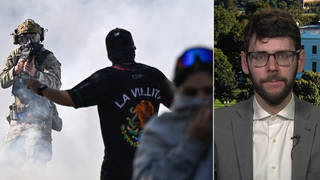
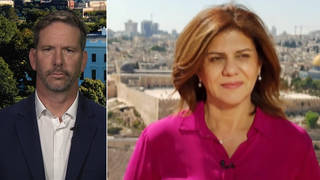
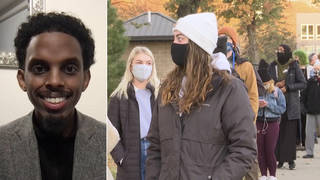
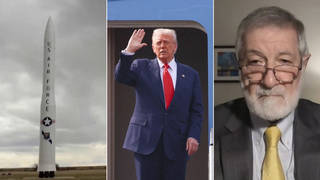





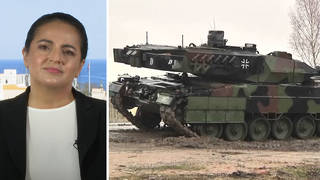
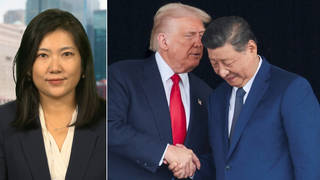
Media Options